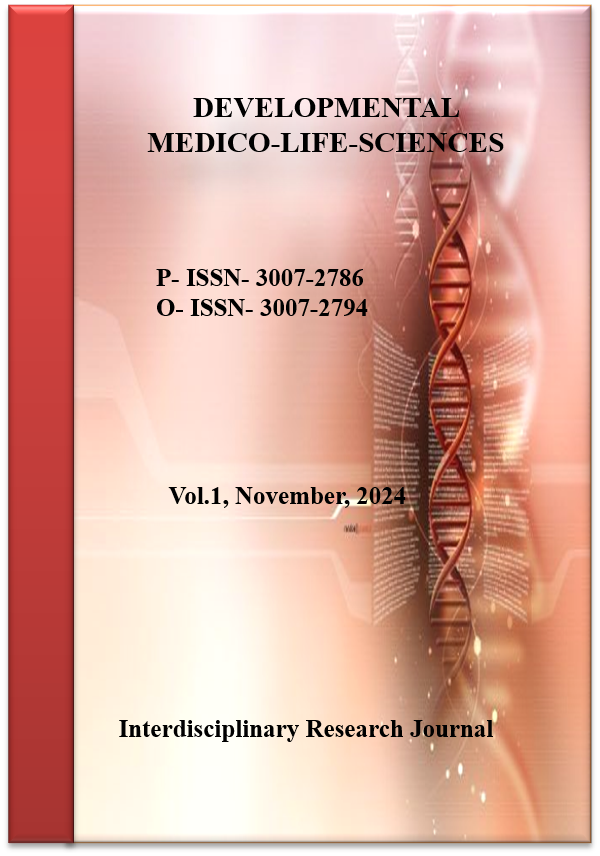The Emerging Role of lncRNAs in Cancer Therapy
Therapeutic Potential of lncRNAs
DOI:
https://doi.org/10.69750/dmls.01.09.086Keywords:
Cancer therapy, biomarkers, drug resistance, precision oncology, therapeutic targets, LncRNAsAbstract
In recent decades, cancer biology has witnessed unprecedented advances in the study of cancer biology, and long noncoding RNAs (lncRNAs) are now known to play central roles in cancer progression, regulation, and therapeutic response[1]. Since their discovery, lncRNAs have been quickly becoming the focus of oncology research, given their critical roles in gene expression regulation, tumor microenvironment regulation, and therapy resistance, and are now once thought of as transcriptional noise. These discoveries hold promise for developing novel diagnostic biomarkers as well as targeted therapies, furthering the field of precision oncology[2].
Types of lncRNAs:
LncRNAs can be grouped according to their location in the genome, structure, and mode of action. The major types include:
Intergenic lncRNAs (lincRNAs):
They are transcribed from regions between protein-coding genes and do not require regulation of adjacent genes[3].
Intronic lncRNAs:
These lncRNAs originate from introns of protein-coding genes and either regulate their host genes or are independent.
Sense lncRNAs:
They transcribe from the same strand and region of the same genes as protein-coding genes, but code for nothing[4].
Antisense lncRNAs:
They are transcribed from the opposite strand of protein-coding genes and regulate their expression through complementary base-pairing.
Enhancer lncRNAs (eRNAs):
These lncRNAs were transcribed from enhancer regions and act to enhance the transcription of nearby genes.
Circular lncRNAs (circRNAs):
CircRNAs are highly stable and formed by back-splicing events, by competing with miRNAs for binding and regulating the expression of genes.
This classification underscores the structural complexity and versatility of lncRNAs in cancer biology and the diversity of lncRNAs[3].
Functional Complexity of lncRNAs:
The class of lncRNAs comprises diverse noncoding RNAs that are longer than 200 nucleotides. As a result, they show exquisite versatility in the regulation of gene expression at multiple levels, including epigenetic, transcriptional, and post-transcriptional, through interactions with DNA, RNA, and proteins. The ability of lncRNAs to functionally plasticity allows them to orchestrate key biological processes such as proliferation, apoptosis, metastasis, angiogenesis, and immune evasion[5].
Importantly, they are dysregulated in several cancers including lung, breast, colorectal, and head and neck squamous cell carcinoma (HNSCC), making them oncogenes or tumor suppressors. The last few years have also revealed that lncRNAs may modulate key signaling pathways such as PI3K/AKT, Wnt/β-catenin, p53, and NF-κB to influence cancer cell survival, metastasis, and drug resistance, directly. For example, lncRNA MALAT1 and HOTAIR are well-established oncogenic lncRNA that are associated with metastasis and poor prognosis, while MEG3 and GAS5 are tumor suppressor lncRNA that induce apoptosis and inhibit proliferation. The intricate and context-specific functions of lncRNAs in cancer progression are underscored by this dual nature[6].
Therapy Resistance and LncRNAs:
Therapy resistance is one of the major impediments to cancer treatment, frequently resulting in disease recurrence and poor patient outcomes. More and more evidence is showing that lncRNAs are key mediators of resistance to chemotherapy, radiotherapy, and targeted therapies. These mechanisms include epithelial-mesenchymal transition (EMT), autophagy regulation, drug efflux pump modulation, and apoptosis inhibition[7].
As an example, lncRNA H19 has been shown to confer resistance to tyrosine kinase inhibitors (TKIs) in lung cancer by upregulating the key enzyme in glycolysis, PKM2. Like for UCA1 and PVT1, lncRNAs have been shown to promote cisplatin resistance by sponging tumor suppressive miRNAs and activating pro-survival pathways. If we can target these resistance-associated lncRNAs, we can sensitize cancer cells to therapy and improve their effectiveness[8].
lncRNAs as Biomarkers and Therapeutic Targets:
lncRNAs are unique in their expression profiles and high tissue specificity, and thus they are promising candidates as cancer biomarkers. Detection in these fluids is possible and they provide minimally invasive diagnostic and prognostic tools. There are already lncRNAs such as PCA3 (prostate cancer) and HULC (hepatocellular carcinoma) with the potential to be used as diagnostic markers for their clinical translation[9]. In addition, this is a new therapeutic strategy targeting lncRNAs. Silencing of oncogenic lncRNAs or restoration of tumor suppressive lncRNAs has been performed with technologies including RNA interference (RNAi), antisense oligonucleotides (ASO), and CRISPR/Cas systems. The stability and bioavailability of lncRNA targeting therapeutics further enhanced by nanoparticle-based delivery systems hope to be successful in clinical practice[10].
Future Perspectives and Challenges:
Despite this promise, there are still major challenges to overcome in the therapeutic potential of lncRNAs. Current lncRNA mechanisms and context-dependent functions are not well understood, and no effective delivery system exists to facilitate clinical application. In addition, personalized approaches to lncRNA-based therapies are needed for the heterogeneity of cancer[11].
Future research should unweave the molecular interactions of lncRNAs in cancer, identify reliable biomarkers for therapy response, and explore new delivery approaches of lncRNA targeting drugs. To bring these discoveries to the patients, collaborative efforts that combine multi-omics technologies, artificial intelligence, and clinical trials will be critical[12, 13].
CONCLUSION
LncRNAs are emerging as a cancer therapeutic agent, adding a new paradigm to cancer biology. lncRNAs are key regulators of tumorigenesis, therapy resistance, and immune modulation, and thus have great potential to improve cancer diagnosis, prognosis, and treatment. As technologies advance lncRNAs may one day transform precision oncology and bring new hope to patients fighting this formidable disease.
Downloads
References
Jiang MC, Ni JJ, Cui WY, Wang BY, Zhuo W. Emerging roles of lncRNA in cancer and therapeutic opportunities. Am J Cancer Res. 2019;9(7):1354-66.
Huarte M. The emerging role of lncRNAs in cancer. Nat Med. 2015;21(11):1253-61. doi:10.1038/nm.3981
Saadh MJ, Rasulova I, Almoyad MAA, Kiasari BA, Ali RT, Rasheed T, et al. Recent progress and the emerging role of lncRNAs in cancer drug resistance: focusing on signaling pathways. Pathol Res Pract. 2024;253:154999. doi:10.1016/j.prp.2023.154999
Yang L, Tang L, Min Q, Tian H, Li L, Zhao Y, et al. Emerging role of RNA modification and long noncoding RNA interaction in cancer. Cancer Gene Ther. 2024;31(6):816-30. doi:10.1038/s41417-024-00734-2
Jariwala N, Sarkar D. Emerging role of lncRNA in cancer: a potential avenue in molecular medicine. Ann Transl Med. 2016;4(15):271.
Castro-Oropeza R, Melendez-Zajgla J, Maldonado V, Vazquez-Santillan K. The emerging role of lncRNAs in the regulation of cancer stem cells. Cell Oncol (Dordr). 2018;41(6):585-603. doi:10.1007/s13402-018-0406-4
Peña-Flores JA, Bermúdez M, Ramos-Payán R, Villegas-Mercado CE, Soto-Barreras U, Muela-Campos D, et al. Emerging role of lncRNAs in drug resistance mechanisms in head and neck squamous cell carcinoma. Front Oncol. 2022;12:965628. doi:10.3389/fonc.2022.965628
Jiang J, Lu Y, Zhang F, Huang J, Ren XL, Zhang R. The emerging roles of long noncoding RNAs as hallmarks of lung cancer. Front Oncol. 2021;11:761582. doi:10.3389/fonc.2021.761582
Schwarzmueller L, Bril O, Vermeulen L, Léveillé N. Emerging role and therapeutic potential of lncRNAs in colorectal cancer. Cancers (Basel). 2020;12(12):3843. doi:10.3390/cancers12123843
Ahmad M, Weiswald LB, Poulain L, Denoyelle C, Meryet-Figuiere M. Involvement of lncRNAs in cancer cell migration, invasion and metastasis: cytoskeleton and ECM crosstalk. J Exp Clin Cancer Res. 2023;42:173. doi:10.1186/s13046-023-02741-x
Wu S, Wu Y, Deng S, Lei X, Yang X. Emerging roles of noncoding RNAs in human cancers. Discov Oncol. 2023;14:128. doi:10.1007/s12672-023-00728-w
Jiang M-C, Ni J-J, Cui W-Y, Wang B-Y, Zhuo W. Emerging roles of lncRNA in cancer and therapeutic opportunities. Am J Cancer Res. 2019;9:1354-66.
(Duplicate of #1 – removed in final list if needed.)
Ghasemian M, Zehtabi M, Dari MAG, Pour FK, Tabesh GA, Moramezi F, et al. The emerging roles of long non-coding RNA (lncRNA) H19 in gynecologic cancers. BMC Cancer. 2024;24:4. doi:10.1186/s12885-023-11743-z






















